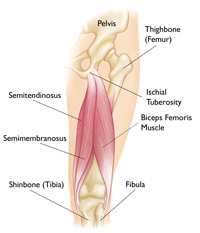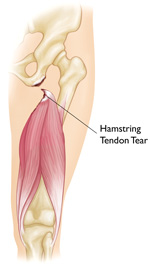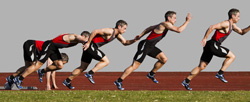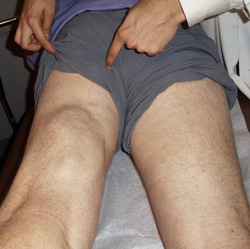
Hamstring Muscle Injuries
Hamstring muscle injuries — such as a "pulled hamstring" — occur frequently in athletes. They are especially common in athletes who participate in sports that require sprinting, such as track, soccer, and basketball.
A pulled hamstring or strain is an injury to one or more of the muscles at the back of the thigh. Most hamstring injuries respond well to simple, nonsurgical treatments.
Anatomy A00408F01.jpg" title="Normal hamstring anatomy " credit=""> Normal hamstring anatomy
Normal hamstring anatomy
The hamstring muscles run down the back of the thigh. There are three hamstring muscles:
- Semitendinosus
- Semimembranosus
- Biceps femoris
They start at the bottom of the pelvis at a place called the ischial tuberosity. They cross the knee joint and end at the lower leg. Hamstring muscle fibers join with the tough, connective tissue of the hamstring tendons near the points where the tendons attach to bones.
The hamstring muscle group helps you extend your leg straight back and bend your knee.
Description A00408F02.jpg" title="A severe hamstring injury where the tendon has been torn from the bone. " credit=""> A severe hamstring injury where the tendon has been torn from the bone.
A severe hamstring injury where the tendon has been torn from the bone.
A hamstring strain can be a pull, a partial tear, or a complete tear.
Muscle strains are graded according to their severity. A grade 1 strain is mild and usually heals readily; a grade 3 strain is a complete tear of the muscle that may take months to heal.
Most hamstring injuries occur in the thick, central part of the muscle or where the muscle fibers join tendon fibers.
In the most severe hamstring injuries, the tendon tears completely away from the bone. It may even pull a piece of bone away with it. This is called an avulsion injury.
CauseMuscle Overload
Muscle overload is the main cause of hamstring muscle strain. This can happen when the muscle is stretched beyond its capacity or challenged with a sudden load.
Hamstring muscle strains often occur when the muscle lengthens as it contracts, or shortens. Although it sounds contradictory, this happens when you extend a muscle while it is weighted, or loaded. This is called an "eccentric contraction."
During sprinting, the hamstring muscles contract eccentrically as the back leg is straightened and the toes are used to push off and move forward. The hamstring muscles are not only lengthened at this point in the stride, but they are also loaded — with body weight as well as the force required for forward motion.
Like strains, hamstring tendon avulsions are also caused by large, sudden loads.
A00408F03.jpg" title="During sprinting, the hamstring muscles are lengthened and loaded as the back leg pushes off to propel the runner forward. " credit="Courtesy Thinkstock © 2015 "> During sprinting, the hamstring muscles are lengthened and loaded as the back leg pushes off to propel the runner forward.
Courtesy Thinkstock © 2015
During sprinting, the hamstring muscles are lengthened and loaded as the back leg pushes off to propel the runner forward.
Courtesy Thinkstock © 2015
Risk Factors
Several factors can make it more likely you will have a muscle strain, including:
Muscle tightness. Tight muscles are vulnerable to strain. Athletes should follow a year-round program of daily stretching exercises.
Muscle imbalance. When one muscle group is much stronger than its opposing muscle group, the imbalance can lead to a strain. This frequently happens with the hamstring muscles. The quadriceps muscles at the front of the thigh are usually more powerful. During high-speed activities, the hamstring may become fatigued faster than the quadriceps. This fatigue can lead to a strain.
Poor conditioning. If your muscles are weak, they are less able to cope with the stress of exercise and are more likely to be injured.
Muscle fatigue. Fatigue reduces the energy-absorbing capabilities of muscle, making them more susceptible to injury.
Choice of activity. Anyone can experience hamstring strain, but those especially at risk are:
- Athletes who participate in sports like football, soccer, basketball
- Runners or sprinters
- Dancers
- Older athletes whose exercise program is primarily walking
- Adolescent athletes who are still growing
Hamstring strains occur more often in adolescents because bones and muscles do not grow at the same rate. During a growth spurt, a child's bones may grow faster than the muscles. The growing bone pulls the muscle tight. A sudden jump, stretch, or impact can tear the muscle away from its connection to the bone.
SymptomsIf you strain your hamstring while sprinting in full stride, you will notice a sudden, sharp pain in the back of your thigh. It will cause you to come to a quick stop, and either hop on your good leg or fall.
Additional symptoms may include:
- Swelling during the first few hours after injury
- Bruising or discoloration of the back of your leg below the knee over the first few days
- Weakness in your hamstring that can persist for weeks
Patient History and Physical Examination
 In this severe tear of the hamstring tendon away from the bone, the muscle has balled up at the back of the thigh.
Reproduced from Frank RN, Walton DM, Erickson B, Nho SJ, Bush-Joseph CA, Verma NN: Acute proximal hamstring rupture: surgical technique. Orthopaedic Knowledge Online Journal 2014. Accessed July 2015.
In this severe tear of the hamstring tendon away from the bone, the muscle has balled up at the back of the thigh.
Reproduced from Frank RN, Walton DM, Erickson B, Nho SJ, Bush-Joseph CA, Verma NN: Acute proximal hamstring rupture: surgical technique. Orthopaedic Knowledge Online Journal 2014. Accessed July 2015.
People with hamstring strains often see a doctor because of a sudden pain in the back of the thigh that occurred when exercising.
During the physical examination, your doctor will ask about the injury and check your thigh for tenderness or bruising. He or she will palpate, or press, the back of your thigh to see if there is pain, weakness, swelling, or a more severe muscle injury.
Imaging Tests
Imaging tests that may help your doctor confirm your diagnosis include:
X-rays. An X-ray can show your doctor whether you have a hamstring tendon avulsion. This is when the injured tendon has pulled away a small piece of bone.
Magnetic Resonance Imaging (MRI). This study can create better images of soft tissues like the hamstring muscles. It can help your doctor determine the degree of your injury.
TreatmentTreatment of hamstring strains will vary depending on the type of injury you have, its severity, and your own needs and expectations.
The goal of any treatment — nonsurgical or surgical — is to help you return to all the activities you enjoy. Following your doctor's treatment plan will restore your abilities faster, and help you prevent further problems in the future.
Nonsurgical Treatment
Most hamstring strains heal very well with simple, nonsurgical treatment.
RICE. The RICE protocol is effective for most sports-related injuries. RICE stands for Rest, Ice, Compression, and Elevation.
- Rest. Take a break from the activity that caused the strain. Your doctor may recommend that you use crutches to avoid putting weight on your leg.
- Ice. Use cold packs for 20 minutes at a time, several times a day. Do not apply ice directly to the skin.
- Compression. To prevent additional swelling and blood loss, wear an elastic compression bandage.
- Elevation. To reduce swelling, recline and put your leg up higher than your heart while resting.
Immobilization. Your doctor may recommend you wear a knee splint for a brief time. This will keep your leg in a neutral position to help it heal.
Physical therapy. Once the initial pain and swelling has settled down, physical therapy can begin. Specific exercises can restore range of motion and strength.
A therapy program focuses first on flexibility. Gentle stretches will improve your range of motion. As healing progresses, strengthening exercises will gradually be added to your program. Your doctor will discuss with you when it is safe to return to sports activity.
Surgical Treatment
Surgery is most often performed for tendon avulsion injuries, where the tendon has pulled completely away from the bone. Tears from the pelvis (proximal tendon avulsions) are more common than tears from the shinbone (distal tendon avulsions).
Surgery may also be needed to repair a complete tear within the muscle.
Procedure. To repair a tendon avulsion, your surgeon must pull the hamstring muscle back into place and remove any scar tissue. Then the tendon is reattached to the bone using large stitches or staples.
A complete tear within the muscle is sewn back together using stitches.
Rehabilitation. After surgery, you will need to keep weight off of your leg to protect the repair. In addition to using crutches, you may need a brace that keeps your hamstring in a relaxed position. How long you will need these aids will depend on the type of injury you have.
Your physical therapy program will begin with gentle stretches to improve flexibility and range of motion. Strengthening exercises will gradually be added to your plan.
Rehabilitation for a proximal hamstring reattachment typically takes at least 6 months, due to the severity of the injury. Distal hamstring reattachments require approximately 3 months of rehabilitation before returning to athletic activities. Your doctor will tell you when it is safe to return to sports.
RecoveryMost people who injure their hamstrings will recover full function after completing a rehabilitation plan. Early treatment with a plan that includes the RICE protocol and physical therapy has been shown to result in better function and quicker return to sports.
To prevent reinjuring your hamstring, be sure to follow your doctor's treatment plan. Return to sports only after your doctor has given you the go-ahead. Reinjuring your hamstring increases your risk of permanent damage. This can result in a chronic condition.
New DevelopmentsPlatelet-rich plasma (PRP) is currently being investigated for its effectiveness in speeding the healing of hamstring muscle injuries. PRP is a preparation developed from a patient's own blood. It contains a high concentration of proteins called growth factors that are very important in the healing of injuries.
A few treatment centers across the country are incorporating PRP injections into the nonsurgical treatment regimen for some hamstring muscle injuries. However, this method is still under investigation and more research is necessary to prove PRP's effectiveness.
If you found this article helpful, you may also be interested in Sprains, Strains and Other Soft Tissue Injuries.
Source: http://orthoinfo.aaos.org/topic.cfm?topic=A00408
